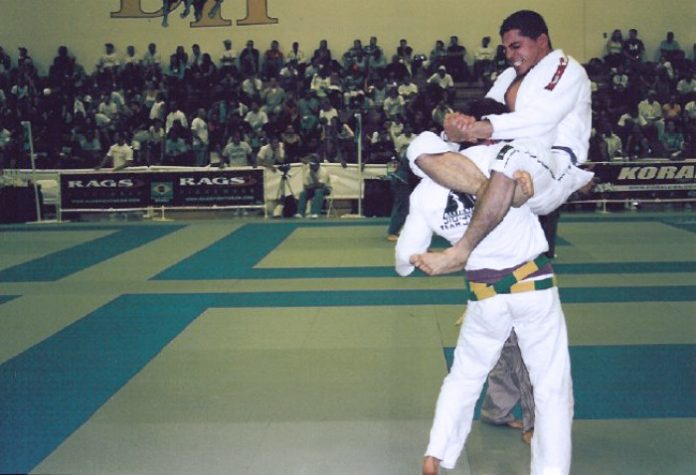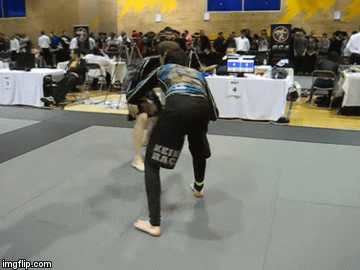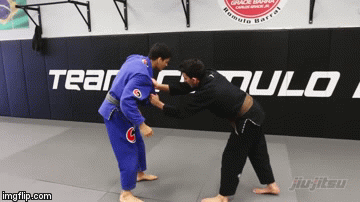
When you first witness a flying submission, your mind focuses on two main things. First, that it is a beyond cool, bad-ass move. Secondly, you ask yourself how you can learn to do that quickly and painlessly. While I completely agree with the first notion, the second is a bit more complicated. Learning anything in BJJ fast is hard. With flying submissions, it is plain impossible. I have to stress out here that if you choose to ignore this fact, you’ll more than likely end up really injured, or injure someone else. Learning a flying submission is a process just like learning break falls or armbars. You need to first be aware of, then understand and finally learn every step fo the move. Because, yes, flying submissions do have steps and setups a well.
The appeal of flying submissions is very easy to see. Who wouldn’t like to end a fight in a truly spectacular fashion? Flying submissions are probably the top of the hill when it comes to finishes. In essence, they’re shortcuts that remove most of what defines a BJJ match. With a flying submission, you jump (or fly) right to the end, skipping everything in the middle. While this is a nice shortcut to have as an option, like all shortcuts worth taking, it comes at a price. And, there’s no way for anyone to avoid paying it.
The price that I’m talking about comes in the form of a dilemma. If you really like to learn flying submissions you’ll need to spend a lot of time learning how to perform them correctly. Even more so, you’ll probably have to focus on just one flying move. The other end of the dilemma is ending up injured or giving up position in tournaments
Flying Submissions – An Assesment
Let’s look at flying submissions in a completely honest fashion. They’re difficult moves that beginners should not even think about attempting. Insufficient knowledge and understanding of what you’re trying to do can only result in a negative outcome. Most often, this is going to happen in the form of an injury.
Flying submissions area advanced moves because they have certain pre-requisites. For one, you need to actually know how the submission works in general. Actually, you need to be really good with a submission to even consider going for a flying setup. So if you are that set on learning of lying submission, master the basics first. Even as a beginner, choose your submission and start learning how it works and how to get there. Because flying is just one way of entering into a submission move.
The consequences of improperly executed flying submission can be really severe. Anything you do wrong in BJJ carries a certain risk, but flying changes the whole complexion of it. Whenever you’re “flying” your whole body is going to be without a base of support at one point in time. Unless you really know when, how and in which direction to “fly”, you’ll miss out on the move. As a result, you’ll most likely land in an awkward fashion that can leave you injured. best case scenario, you end up on your back, with nothing to show for it. And that is without even mentioning the injuries you could cause your partner/opponent.
Technical Tips
The key thing to understand about flying submissions is that performing them is not different than performing any other move in BJJ. If you can comprehend that, you’ll be well on your way to mastering them. The best way to approach a flying submission move is in steps. There are three main steps you absolutely need to be aware of.
The Anchor
First and foremost, you need to be in constant contact with your opponent. If you try to just fly through the air to get them, you’ll never succeed. Gi or No-Gi, you need to have correct grips for the submission you’re chasing. This is called an anchor point. You have to hold to the anchor point from the moment you start “flying” to the moment you get the tap.
The Power Source
This is the second crucial step of every flying submission. If you want to fly you need to know how to take off. Logically, since your arms are anchoring you, your legs are going to be the power source. However, you need to know exactly where to place them in regard to the submission you’re chasing. Because going for a flying armbar and a flying guillotine are two very different things.
The Landing
Whenever you go up, you’ll have to come down at one point. How you land has a lot to do with how you set up the previous two steps. If you’re anchored well and you chose the correct power source, landing shouldn’t be difficult as you should be in the submission position by then. Remember that when you’re landing, even if you’re not quite there with the submission, you have to stay tightly anchored to your opponent.
Flying Submissions That Works
Flying Guillotine

To set it up, you must bait your opponent to come low, so that when you fly, you can actually be on top. You need to pul the arm while you propel yourself forward and up, jumping off the mats. At the same time, use the snap-down to get their head down so that you can place the guillotine grip while you’re in the air. As you land, you’ll come down to your feet, forcing the opponent on their back. From there, you can look to finish from a top position or roll onto your back for a classic finish.
Flying Armbar
The flying armbar is next on the ladder of the difficulty of flying submissions. Here you’ll need to rely on your anchor grips a lot, especially with the Gi. Furthermore, your power source is going to change,m as you won’t be jumping off the ground with both feet.


Check out how Bernardo Faria approaches submission hunting. In his “High Percentage Submissions” DVD set you won’t see any submissions that do not work. What you learn from this instruction will serve you from white to black belt, both flying and from more conventional setups.
Flying Triangle
Getting a flying triangle requires experience, precise timing, and some dexterity. This is arguably the most difficult flying submission you can go for, that has a good percentage chance to work.

https://bjj-world.com/guillotine-choke-basics-bjj-submission/


![Darce Choke Encyclopedia – Origins, Mechanics and Variations [2025] BJJ, choke, Brabo, BJJ Darce Choke, D'arce Choke, Darce BJJ Choke](https://bjj-world.com/wp-content/uploads/2017/11/JungPoirierLeeYahoo-218x150.jpg)









![Slicin’ Calves Mikey Musumeci DVD Review [2025] Slicin' Calves Mikey Musumeci DVD Review](https://bjj-world.com/wp-content/uploads/2025/04/slicin-calves-mikey-musumeci-dvd-review-218x150.png)
![Jiu-Jitsu For Old Guys Guard Retention Bernardo Faria DVD Review [2025] Jiu-Jitsu For Old Guys Guard Retention Bernardo Faria DVD Review](https://bjj-world.com/wp-content/uploads/2025/03/old-guys-guard-retention-bernardo-faria-dvd-review-218x150.png)
![X-Guard Trickery Kyle Sleeman DVD Review [2025] X-Guard Trickery Kyle Sleeman DVD Review](https://bjj-world.com/wp-content/uploads/2025/03/x-guard-trickery-kyle-sleeman-dvd-review-218x150.png)
![Countering with Crab Ride Anthony Budion DVD Review [2025] Countering with Crab Ride Anthony Budion DVD Review](https://bjj-world.com/wp-content/uploads/2025/03/countering-with-crab-ride-anthony-budion-dvd-review-218x150.png)
![Closet Closed Guard Craig Jones DVD Review [2025] Closet Closed Guard Craig Jones DVD Review](https://bjj-world.com/wp-content/uploads/2025/03/closet-closed-guard-craig-jones-dvd-review-218x150.png)
![Xanadu Back Takes Levi Jones-Leary DVD Review [2025] Xanadu Back Takes Levi Jones-Leary DVD Review](https://bjj-world.com/wp-content/uploads/2025/03/xanadu-back-takes-levi-jones-leary-dvd-review-218x150.png)
![Jeff Higgs Self Defense Guard BJJ DVD Review [2024] Jeff Higgs Self Defense Guard BJJ DVD Review](https://bjj-world.com/wp-content/uploads/2024/09/jeff-higgs-self-defense-guard-bjj-dvd-review-324x235.png)
![Roger Gracie Guard Passing System DVD Review [2025] Roger Gracie Guard Passing System DVD Review](https://bjj-world.com/wp-content/uploads/2025/02/roger-gracie-guard-passing-system-dvd-review-100x70.png)


![Closed Guard Reintroduced Adam Wardzinski DVD Review [2025] Closed Guard Reintroduced Adam Wardzinski DVD Review](https://bjj-world.com/wp-content/uploads/2025/01/closed-guard-reintroduced-adam-wardzinski-dvd-review-100x70.png)

![Jett Thompson Master Ankle and Aoki Lock DVD Review [2024] Jett Thompson Master Ankle and Aoki Lock DVD Review](https://bjj-world.com/wp-content/uploads/2024/09/jett-thompson-master-ankle-and-aoki-lock-dvd-review-100x70.png)


![Kill The Underhook Dima Murovanni DVD Review [2024] Kill The Underhook Dima Murovanni DVD Review](https://bjj-world.com/wp-content/uploads/2024/10/kill-the-underhook-dima-murovanni-dvd-review-100x70.png)




![X-Guard Trickery Kyle Sleeman DVD Review [2025] X-Guard Trickery Kyle Sleeman DVD Review](https://bjj-world.com/wp-content/uploads/2025/03/x-guard-trickery-kyle-sleeman-dvd-review-100x70.png)

![Giancarlo Bodoni DVD Bundle Essential Connections Full Review [2024] Giancarlo Bodoni DVD Bundle Essential Connections Full Review](https://bjj-world.com/wp-content/uploads/2024/09/giancarlo-bodoni-dvd-bundle-essential-connections-100x70.png)
![Double Sleeve Guard Jon Thomas BJJ DVD Review [2024] Double Sleeve Guard Jon Thomas BJJ DVD Review](https://bjj-world.com/wp-content/uploads/2024/10/double-sleeve-guard-jon-thomas-bjj-dvd-review-100x70.png)



![Darragh O’Conaill Crucifix Encyclopedia DVD Review [2024] Darragh O'Conaill Crucifix Encyclopedia DVD Review](https://bjj-world.com/wp-content/uploads/2024/10/darragh-oconaill-crucifix-encyclopedia-dvd-review-100x70.png)

![Simplify the System Side Scissor Brian Glick DVD Review [2024] Simplify the System Side Scissor Brian Glick DVD Review](https://bjj-world.com/wp-content/uploads/2024/09/side-scissor-brian-glick-dvd-review-2024-100x70.png)



![Don’t Stand Up Chris Wojcik DVD Review [2024] Don't Stand Up Chris Wojcik DVD Review](https://bjj-world.com/wp-content/uploads/2024/11/dont-stand-up-chris-wojcik-dvd-review-100x70.png)
![Best Marcelo Garcia Techniques by Team Marcelo Garcia DVD Review [2025] Best Marcelo Garcia Techniques by Team Marcelo Garcia DVD Review](https://bjj-world.com/wp-content/uploads/2025/02/best-marcelo-garcia-techniques-dvd-review-100x70.png)